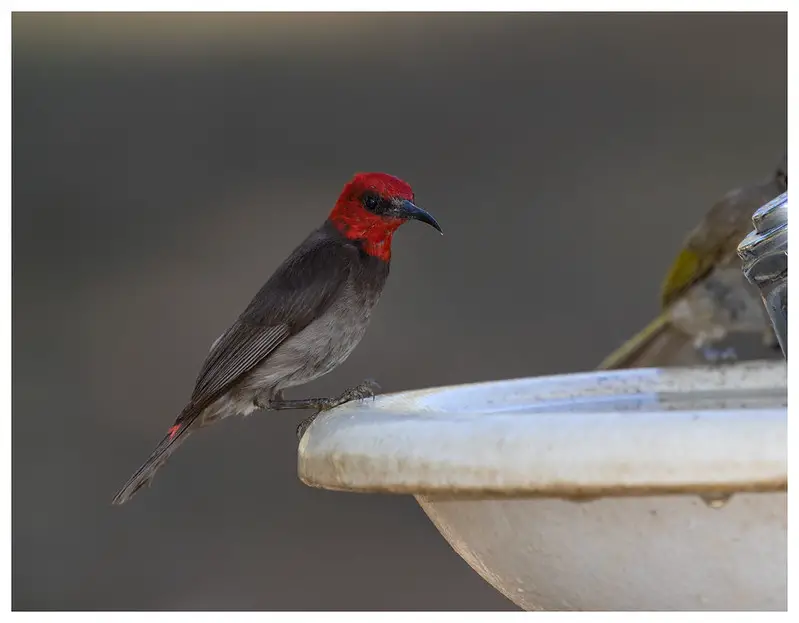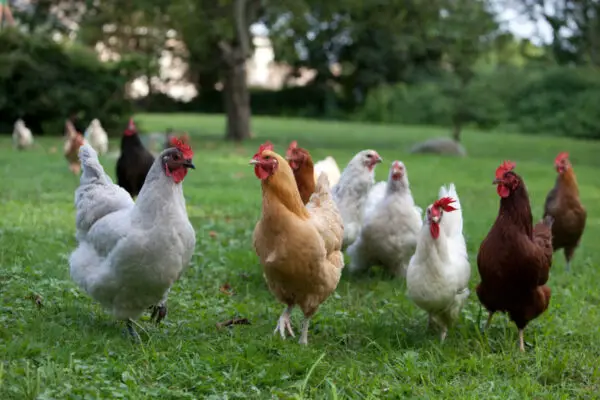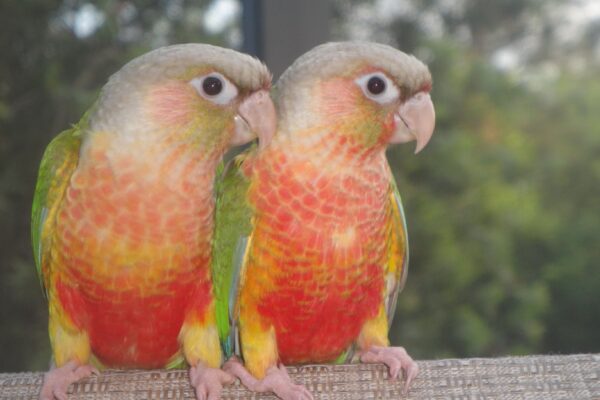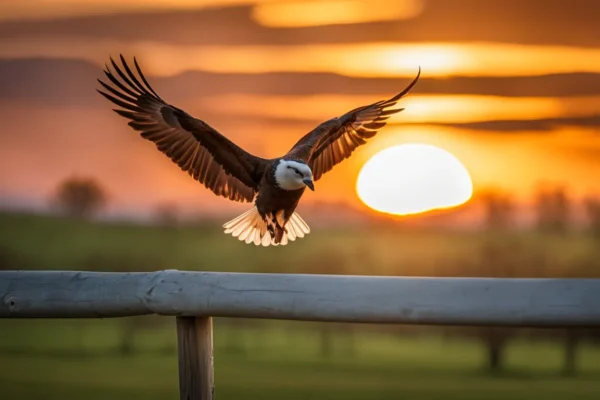Red is considered to be the color of intense emotion, passion, and love. It is always appealing to the eyes and captures the attention of the viewer. So, if you have come across black birds with red heads and are curious to know what bird it was? you are at the right place.
Many birds in the United States and Canada have total or partly red heads. They may sometimes be a little hint of crimson. The red tint might be more orange or pink depending on the situation. To further explore black birds with red heads we have compiled a list. Do read it till the end as the list has got some birds that you may have never heard before.
List of Black Birds with Red Heads
The list is arranged from small to large birds keep reading to know more about black birds with red heads
1. Crimson-crowned Flowerpecker

- Scientific name: Prionochilus percussus
- Size: Approximately 9 centimeters (3.5 inches)
- Origin: Southeast Asia (found in countries such as Thailand, Myanmar, and Malaysia)
Southeast Asian woodlands are home to the little passerine bird known as the crimson-crowned flowerpecker. They have a brilliant red head, a red mark on their breast, black wings, yellowish belly, and a tail, and are usually around 3.5 inches long.
They consume a variety of insects, such as beetles, ants, and caterpillars. Because they are monogamous, couples of crimson-crowned flowerpeckers remain together forever. They lay 2-4 eggs each clutch and make their nests from twigs high in the trees. Their booming “tzeet” sounds are well-known.
2. Red-headed Manakin

- Scientific name: Ceratopipra rubrocapilla
- Lifespan: Up to 5 years
- Size: Approximately 9-10 centimeters (3.5-4 inches)
- Origin: Central and South America (found in regions such as Panama, Colombia, and Ecuador)
Red-headed manakin is small red-headed birds, also known as Ceratopipra rubrocapilla and is found in Brazil’s tropical lowland woods. They have sexual dimorphic features, much as other birds in their family. Males have a body made entirely of black, a red head, and pinkish feet.
Females, on the other hand, have white underparts and are olive-green in color. Each bird is around 4 inches long and 0.3 oz in weight.
Small groups of these birds are often seen hunting for seeds and insects on the ground. They are very gentle and often approach humans for food. They make a cup-shaped nest made out of grasses or other materials and is often positioned low in a tree or shrubs. The female lays 4-6 eggs, which she then takes care of for 12–13 days.
What food do red-headed manikins eat? mostly insects and seeds. This bird is also well-known for its “drree-dit” noises.
3. Black-bellied Myzomela

- Scientific name: Myzomela erythromelas
- Size: Approximately 9-10 centimeters (3.5-4 inches)
- Origin: Southeast Asia and Oceania (found in countries such as Indonesia, Papua New Guinea, and the Solomon Islands)
The black-bellied myzomela, also known as Myzomela erythromelas, is a tiny passerine bird that may be found in New Guinea and other adjacent islands. It is striking and beautiful. It is a member of the family of honeyeaters.
The male is stunningly red-headed and has a black belly, neck, and upper parts, while the female has a buffy underbelly and olive-green upper parts. It is sexually dimorphic. The bill of both sexes is long and curved. They are usually seen in couples or small groups. It eats insects in addition to floral nectar as its major source of food.
4. Wire-tailed Manakin

- Scientific name: Pipra filicauda
- Lifespan: Up to 10 years
- Size: Approximately 10-11 centimeters (4-4.5 inches)
- Origin: Central and South America (found in regions such as Brazil, Peru, and Bolivia)
The sexually dimorphic bird species wire-tailed manakins are found in Central America. The females are typically olive-green, while the males are black with redheads. The males utilize their long, slender tails in displays to entice females.
These birds often engage in chasing each other around during courting rituals and are quite territorial and aggressive against other males. Usually living in couples or small groups, wire-tailed manakins eat fruit, insects, and nectar.
5. Crimson-hooded Manakin

- Scientific name: Pipra aureola
- Lifespan: Up to 6 years
- Size: Approximately 10-11 centimeters (4-4.5 inches)
- Origin: Central and South America (found in regions such as Venezuela, Guyana, and Suriname)
Manacus vitellinus, a tiny passerine bird of the manakin family is known as the crimson manakin. It may be found in Venezuela and Brazil. The male is strikingly colored, having black upper parts and a vivid red head with yellow undertones. The female is an olive-green color. While their kids resemble the females in appearance due to their dull plunge.
Open woods and forest borders are where you may find this species. The male defends its territory by singing from an exposed perch. A tiny cup-shaped nest made of plant fibers is constructed by the female, who then incubates it for around two weeks. Both parents feed the chicks, and after another two weeks or so, they become independent.
6. Red-headed Myzomela

Image Source
- Scientific name: Myzomela erythrocephala
- Size: Approximately 11-12 centimeters (4.5-5 inches)
- Origin: Australia and Papua New Guinea
Northern Australia is the home of the little passerine bird known as the red-headed myzomela. Its bottom is grey, and it has a brilliant red head, black wings, and a back. The species exhibits sexual dimorphism, with the female showing a reddish face and a body that is grey-brown in color.
The red-headed myzomela may be highly loud, uttering high-pitched cries whether perched or flying. Both gentle “swip-swip” notes and sharp “charrrk-charrk” noises may be heard in their cries.
Notice the long, black, curving beak? They utilize it to consume fruit and nectar as food. June to October is the beginning of their breeding season. They make nests that may accommodate two to three eggs out of plant fiber and leaves. Four weeks after hatching is about when chicks leave their homes.
Myzomela with redheads is widespread and fascinating to see. Add this red-headed bird to your must-see list if you want to go bird-watching in Australia.
7. Scarlet-horned Manakin

Image Source
- Scientific name: Pipra cornuta
- Lifespan: Up to 6 years
- Size: Approximately 10-11 centimeters (4-4.5 inches)
- Origin: Central and South America (found in regions such as Colombia, Ecuador, and Peru)
Small passerine birds known as scarlet-horned manakins (Pipra cornuta) inhabit the Neotropical ecozone. The male of this species is visually remarkable, with a black coat, a red head, and tufts that resemble horns on the sides of its head.
Females have an olive-green top body and a whitish underbelly. It is a vocal bird, making a sequence of high-pitched trills as part of its song. Forests and other woods are home to scarlet-horned manakins, which usually perch quite high in the trees.
The male develops and guards a territory, and they are monogamous. A little cup-shaped nest made of plant material is constructed by the female, who then incubates it for around two weeks. The chicks are nourished by both parents for around six weeks after hatching before becoming independent.
8. Rote Myzomela

- Scientific name: Myzomela irianawidodoae
- Lifespan: Information not available
- Size: Approximately 11 centimeters (4.5 inches)
- Origin: Rote Island, Indonesia
The Rote Myzomela, an indigenous species to the Indonesian Lesser Sundas islands of Rote and Kisar, is another black bird with a redhead. The Rote Myzomela is a little passerine bird with a length of 4 inches. The male is vividly colored, with a black body and a crimson head. The female has more brownish, duller fur. The tails of both sexes are lengthy.
The Rote Myzomela mostly eats insects, however, they may also consume floral nectar. They are often seen searching for insects in the underbrush in couples or small groups or sitting on a limb singing loudly.
9. Black-bellied seedcracker

- Scientific name: Pyrenestes ostrinus
- Lifespan: Up to 10 years
- Size: Approximately 12-13 centimeters (4.5-5 inches)
- Origin: Sub-Saharan Africa (found in countries such as Nigeria, Cameroon, and Congo)
The African tropical woodlands are home to the little passerine bird known as the black-bellied seedcracker. It belongs to the genus Pyrenestes and to the family Estrildidae. The English ornithologist Philip Sclater initially identified this species in 1855.
The average length and weight of the black-bellied seedcracker are 5 inches and 0.5 oz. It has a crimson head and tail and is mostly black. Females and juveniles have a brown color. The legs are brownish, and the beak is black.
The black-bellied seedcracker lives in gardens, plantations, and wooded areas close to water.
10. Red-headed malimbe

Image Source
- Scientific name: Malimbus rubricollis
- Lifespan: Up to 10 years
- Size: Approximately 16-18 centimeters (6.5-7 inches)
- Origin: Sub-Saharan Africa (found in countries such as Nigeria, Ghana, and Cameroon)
The African rainforest is home to a brand-new species of bird with a vivid red head. Malimbus rubricollis is the official scientific name for the bird, which is a malimbe. It belongs to the Malimbus family, which also contains other black birds with red heads.
The malimbe is a little bird with a length of around 9 inches. It has a black body and a crimson head. The timid bird likes to remain concealed in the thick foliage of the jungle.
Not much is known about the malimbe’s ecology. It is said that they eat seeds and maybe insects. Malimbe has been seen grazing on fruit trees and flowering shrubs near streams and rivers.
11. Scarlet-banded barbet

- Scientific name: Capito wallacei
- Lifespan: Up to 15 years
- Size: Approximately 16-18 centimeters (6.5-7 inches)
- Origin: Central and South America (found in regions such as Colombia, Ecuador, and Peru)
A species of bird belonging to the capitonidae family is the scarlet-banded barbet, or Capito wallacei. Its preferred habitats are subtropical or tropical montane forests or wet tropical lowland forests.
The bird weighs up to 2.8 oz and is around 7 inches long. It has a red head, a yellow belly, and a black back. this redhead bird breeds from March through May. The delicate “tdddd” tone in their song is what makes them stand out.
12. Acorn woodpecker

Image Source
- Scientific name: Melanerpes formicivorus
- Lifespan: Up to 15 years
- Size: Approximately 20-23 centimeters (8-9 inches)
- Origin: North and Central America (found in regions such as the United States, Mexico, and Costa Rica)
Small North American birds known as acorn woodpeckers are readily identified by their black and white plumage, red heads. Open forests, parks, and gardens are frequent places to see these birds.
While they often hunt for food on the ground, they may sometimes be seen up in trees where they look for insects. Acorn woodpeckers lay between three and six eggs in a hole that the male drills in a tree during the late winter and early spring breeding season. About two weeks pass during incubation, and both parents contribute to feeding the young.
13. Crimson-headed partridge

Image Source
- Scientific name: Haematortyx sanguiniceps
- Lifespan: Information not available
- Size: Approximately 35-38 centimeters (14-15 inches)
- Origin: Southeast Asia (found in countries such as Myanmar, Thailand, and Vietnam)
The haemothorax sanguiniceps, sometimes known as the crimson-headed partridge, was originally identified in the 1800s. It is a tiny, black, red-headed bird from the pheasant family that is mostly found in high areas of Southeast Asia
This species has a rufous breast, a black body, and a red head. Both sexes have brownish legs and black eyes with a yellow eye ring.
The crimson-headed partridge mostly consumes insects, however, it may occasionally consume seeds and berries. This species sometimes forms small flocks but is mostly only seen individually or in pairs.
This black bird with a red head produces up to 8 brownish eggs that take around 19 days to hatch. They are recognized for their clucking “kak-kak” and metallic “ring-ying.”
14. Red-headed woodpecker

Image Source
- Scientific name: Melanerpes erythrocephalus
- Lifespan: Up to 9 years
- Size: Approximately 19-23 centimeters (7.5-9 inches)
- Origin: North America (found in regions such as the United States and Canada)
One of the most recognized woodpeckers in North America is the Redheaded Woodpecker. They are medium-sized woodpeckers with a 9-inch body and a 16-inch wingspan.
both male and female woodpeckers have a red head, black back and wings, and white underparts.
Red-headed woodpeckers like to live in Open forests, parks, and gardens. They eat fruit, nuts, spiders, and insects which they find in tree bark by scratching into it. Furthermore, they also use fissures to store food.
They construct up-shaped nests in which the female lays 4-6 eggs, with assistance from both parents in caring for the young birds and incubating the eggs.
15. Scarlet-headed blackbird

Image Source
- Scientific name: Amblyramphus holosericeus
- Lifespan: Up to 10 years
- Size: Approximately 22-25 centimeters (8.5-10 inches)
- Origin: South America (found in regions such as Argentina, Bolivia, and Brazil)
The medium-sized red-headed blackbirds are called scarlet-headed blackbirds. This huge black bird with a red head can be found from Argentina to Southern Brazil
Both sexes have bright red heads and mostly black plumage. The juvenile has a duller appearance than the adult but still retains the distinctive crimson head. This species lives in open areas close to bodies of water, such as lakes and ponds.
A big cup nest made of sticks is constructed by the scarlet-headed blackbird next to water in a tree or shrub. The female lays 2–3 eggs, which she then cares for 11–13 days. Both parents feed the chicks, who eventually leave the nests after around 16 days.
16. Pileated woodpecker

Image Source
- Scientific name: Dryocopus pileatus
- Lifespan: Up to 15 years
- Size: Approximately 40-49 centimeters (16-19 inches)
- Origin: North America (found in regions such as the United States and Canada)
The pileated woodpecker is another type of the red-headed blackbird. It is the biggest woodpecker in North America, growing up to 19 inches. Their distinctive red crest and black and white plumage make them easy to spot.
their strong bill allows them to chisel through the bark. These birds may be found in a range of settings, including parks, woodlands, and urban areas. The diet of pileated woodpeckers includes a variety of foods, such as nuts and fruits. They store food for future use, much like their aforementioned relatives.
The pileated woodpecker builds its nests in tree cavities because it is a cavity nester. They usually remain partners for life and are monogamous. The powerful sounds of pileated woodpeckers are well recognized and audible from a wide distance.
17. Crimson-crested woodpecker

Image Source
- Scientific name: Campephilus melanoleucos
- Lifespan: Up to 15 years
- Size: Approximately 35-40 centimeters (14-16 inches)
- Origin: South America (found in regions such as Brazil, Argentina, and Paraguay)
A spectacular bird found in South America is the crimson-crested woodpecker. The adult has a black back, a strongly banded bottom, and a reddish head. They weigh around 10 ounces and are roughly 15 inches long.
These woodpeckers consume insects while living in woods and woodlands. They can borrow an existing nest from another bird while making their nests in tree holes. Due to their monogamous nature, both the male and female of these birds alternate incubating the eggs. The chicks spend roughly five weeks in the nest after being born.
19. Turkey vulture

Image Source
- Scientific name: Cathartes aura
- Lifespan: Up to 20 years
- Size: Approximately 64-81 centimeters (25-32 inches)
- Origin: North and South America (found in regions such as the United States, Mexico, and Brazil)
Large raptors found in North and South America include turkey vultures and turkey buzzards. It belongs to the Cathartidae family, which also contains the bigger yellow-headed vulture and the black vulture. One of the most prevalent vultures in North America is this big red-headed black bird.
The turkey vulture has exposed red skin on its head, giving it a reddish look, unlike other birds on this list that have red spots on their heads. The rest of its body is black in color. It can rip flesh with its long, hooked beak. The wingspan of a turkey vulture may measure up to 6 feet.
The food source for turkey vultures is dead animals. They often fly above in search of food. They can devour up to 2 pounds of rotting meat each day and are quite effective at doing so.
How to scare off turkey vultures? Using non-lethal techniques is the best way to frighten them away from your garden feeders. Use a yard hose to spray them or install an ultrasonic repellant.
Final thoughts on black birds with Red Heads:
Blackbirds with red heads are always fascinating to watch but they are quite rare so one may not know what species of bird it is. with the list above we hope that you will be able to identify the species of these gorgeous birds. well, some may not find the vulture added to the list specifically gorgeous but they have their place in the ecosystem. that’s why they are included in the list. we hope you enjoyed the blog and if you have enjoyed it, you may also like birds that lay blue eggs
Further Readings
- Black Birds with Yellow Eyes
- Black Birds with Red Eyes
- Black Birds with white Beaks
- Black Birds with Green Heads
- Black Birds with White Bellies
- Black Birds with White Spots
- Black Birds with Orange Wings
- Black Birds with White Stripes on Wings
- Black Birds with Yellow Heads
- Black Birds with Gray Heads
- Black Birds with Blue Heads
- Black Birds with Black Beaks
Here is the summary of all the Black Birds with Red Heads
- Crimson-crowned Flowerpecker
- Red-headed Manakin
- Black-bellied Myzomela
- Wire-tailed Manakin
- Crimson-hooded Manakin
- Red-headed Myzomela
- Scarlet-horned Manakin
- Rote Myzomela
- Black-bellied seed cracker
- Red-headed malimbe
- Scarlet-banded barbet
- Acorn woodpecker
- Crimson-headed partridge
- Red-headed Woodpecker
- Scarlet-headed blackbird
- Pileated woodpecker
- Crimson-crested woodpecker
- Turkey vulture
FAQS
Why Do Male Birds Have More Color Than Female Birds?
When it comes to birds, the males are often more colorful and beautifully marked than the females. He needs these vivid colors to catch the eye of a female and impress them. Females opt for bright colors because it indicates health and fitness, which might indicate that the man would make a good father or at the very least has decent genes.
What Causes the Colors in Birds?
Light is reflected from pigments and other tiny structures in feathers to create the colors we see on bird plumage.





![10 Beautiful Red Birds in New York [Images + IDs]](https://birdsology.com/wp-content/uploads/2023/03/14235697222_3abaaf211f_b-600x400.jpg)
